Good architecture celebrates design with nature. While homes are your go-to places to feel secure, sustainable houses make a promise of safety to the natural environment. These are innovations in designs offering spectacular results ensuring energy efficiency and minimizing running costs.
The worth of a structure doesn’t lie in the building’s cost, rather, it can only be evaluated through its impact on surroundings and environment. With certain breakthroughs in technology, designers have cracked the code for a greener approach by building sustainable houses. Let’s look at a few of the sustainable homes across the globe with a deep amalgamation of nature within the built environment.
17 Most Incredible Sustainable Houses Embedded in Nature
Sustainability is much more than a mere concept. It’s about exploration in terms of planning, mood board, and building techniques that result in sustainable homes harmonizing and blending with nature while walking on the paths of energy efficiency.
Let’s look at the 17 most incredible sustainable houses nestling amongst natural landscapes.
1. Waste House, University of Brighton
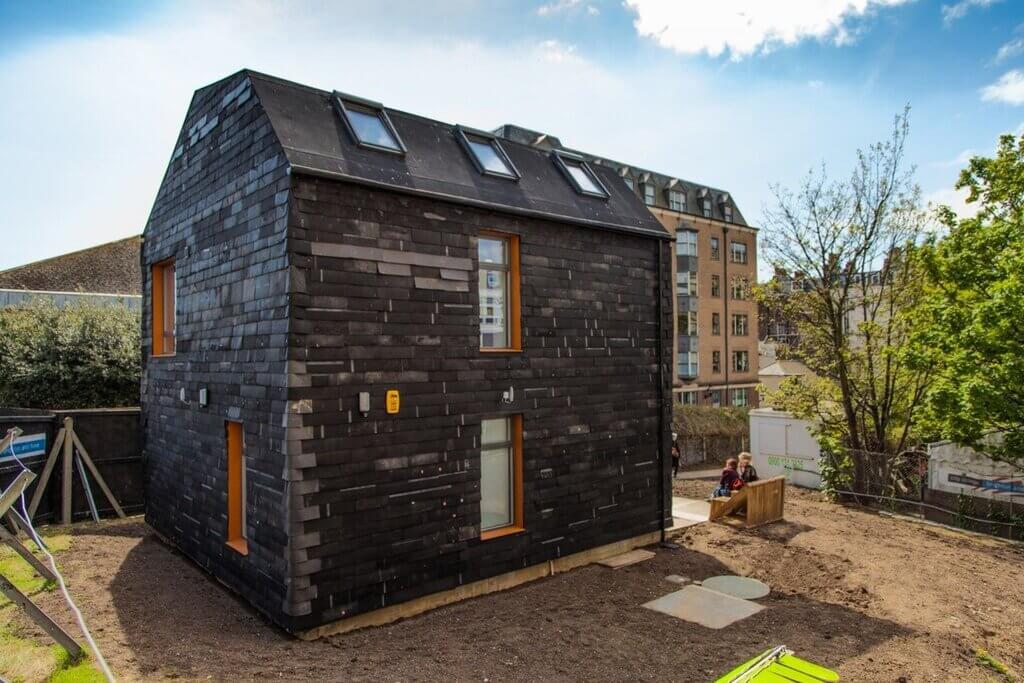
With the notion of denying the existence of waste and referring to it as just elements in the wrong place, Waste House by the University of Brighton is one of the small sustainable homes built of discarded materials. It is the first structure in the United Kingdom to be built out of rubbish.
The construction material was derived from normal household waste with the mixing of construction waste. The structure is composed of 4000 discarded DVD cases, 2000 carpet tiles, 20,000 used toothbrushes, and 2000 floppy discs. A one-of-its-kind mood board offers unique aesthetics to the facade. The structure serves as a living example of how the notion of waste is so wrongly being used and how even the simplest of items can prove to be extremely utilitarian for the design of sustainable homes.
The design of the building follows a contemporary language running on minimal energy. It’s a powerful message for practicing designers and aspiring architects to relook into what all goes into building a sustainable property. This is one of the experimental projects which is now being utilized as a design workshop for the students of the University of Brighton. Built out of a sustainable approach, the workshop is a place for students to explore the world of sustainable development.
2. S House, Vietnam
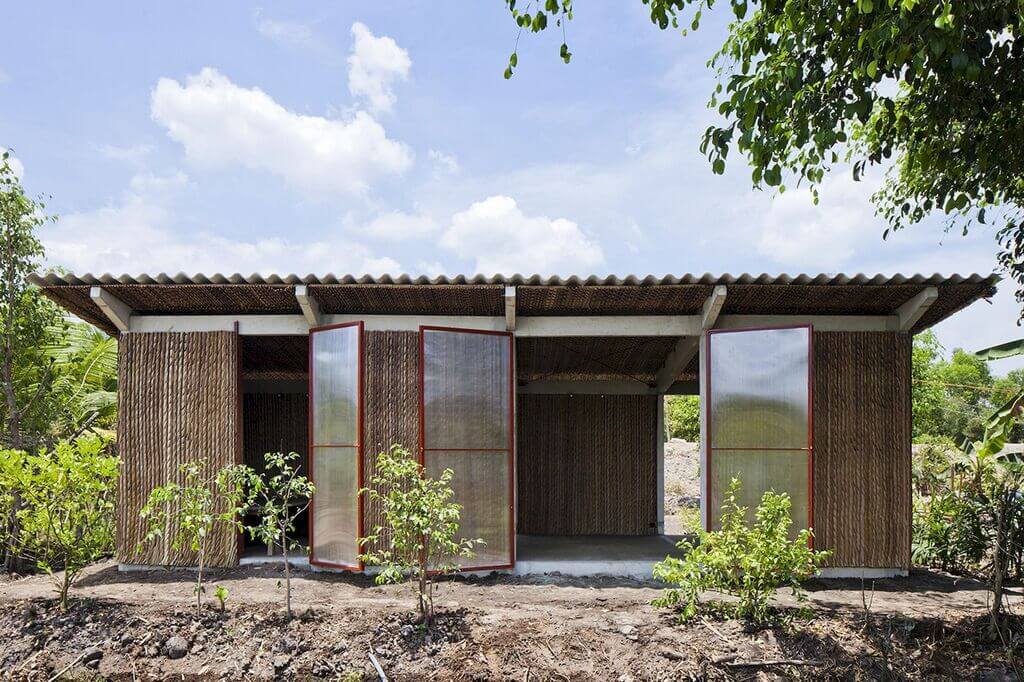
Along with the rise in urbanization, the demand for cheap home solutions is also at a hike. To cater to the societal issue, Vo Trong Nghia Architects proposed pocket-friendly and eco-friendly homes– S House.
These sustainable homes have the most practical approach with local materials like bamboo and thatch composed of Palm leaves. The 30sq.m interiors of these small sustainable homes feature one large space.
The design is guided by the target to hit the low-cost market. With a scope of mass manufacturing, these small sustainable homes are best suited for any locality, be it a heavily crowded slum or a remote site. The easy assembly and portability of these sustainable homes let you carry the house along with you wherever you go. Designers approached the project differently by proposing these sustainable prefab homes that can be dismantled and commuted to another location as per requirements.
3. ZEB Pilot House, Larvik, Norway
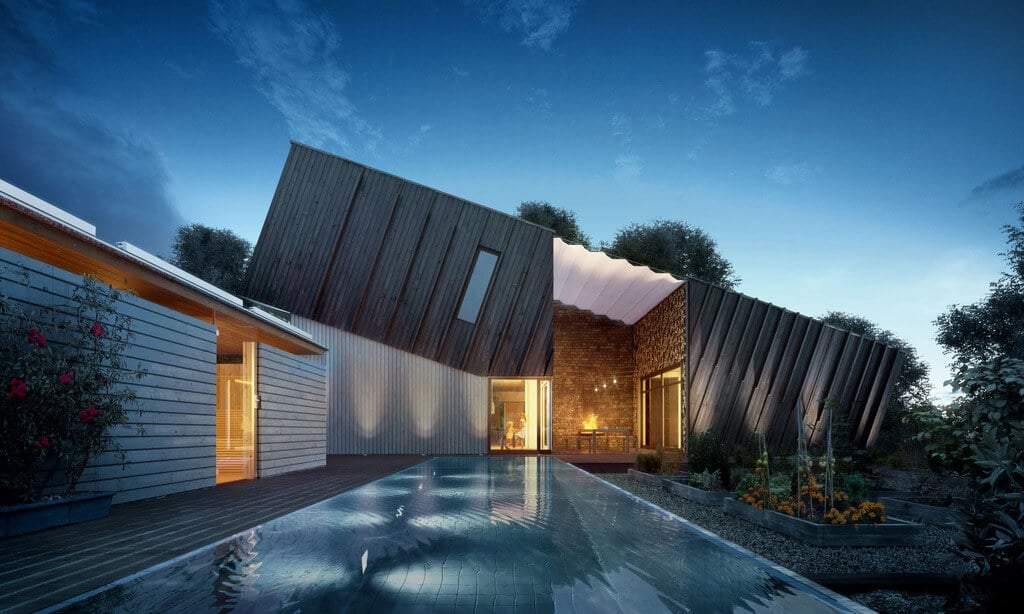
One of the most amazing experimental yet sustainable homes is the Zeb Pilot House designed by Snohetta. The incorporation of solar panels and an energy-efficient approach in the design results in the production of electricity which is thrice the amount consumed by the house.
The collaboration of Snohetta along with the Research Center on Zero Emission Buildings (ZEB) resulted in a home that is comfortable for users to live in an equally positive on the environment. The building envelope serves as a powerhouse with energy-generation offsets the emissions of carbon gasses and directs the entire AEC industry toward a unique approach to sustainability.
From the interiors to exterior amenities like a swimming pool and sauna, every space of the house operated on solar energy letting the users have the best of all the luxury privileges at a minimal running cost. The high performance of these sustainable homes is a result of a kitchen sink that is based on a sustainable route with a photovoltaic array, heat exchanger, rainwater collection provision, and solar panels. Along with catering to the environmental impacts, the sublime palette also serves as a soothing treat for the eyes.
4. Pop-Up House, Southern France

Each one of us must’ve always dreamt of staying in a Lego house. The team at Multipod has enabled this fantasy to come true with Pop-Up House. These sustainable houses are a product of four days’ work with the magic of a single tool– A screwdriver.
The use of pocket-friendly materials is what makes the concept of these sustainable homes a hit with minimal installation costs. The design is all that tomorrow in the construction sector requires. Sustainable prefab homes have excellent insulation with an airtight thermal envelope wrapping the entire building. Though the project is located in Southern France, the smart planning and construction methods eliminate the need for extra heating for this home.
5. Blooming Bamboo

Sustainable homes aren’t only structures built out of local materials. These buildings have a holistic approach where each design element converses with surroundings and nature. This aspect also involves the response to climatic conditions.
Blooming Bamboo is one of the eco-sustainable homes executed by H&P Architects. The project is a prototype that will cater to the mass. With weather considerations, the design has been proposed to be flood-proof with its stilt structure.
The stilts can keep the home safe to a level of 1.5m. The height in other models can be elevated further to 3m. From the core structure to cladding, the material palette is composed of local materials only. The skeleton of the building is composed of bamboo which is further cladded with coconut leaves and fiberboard. These sustainable homes with a vernacular approach will cater to the low-income groups of the society for US$2,500 only.
6. Edgeland House, Austin, Texas
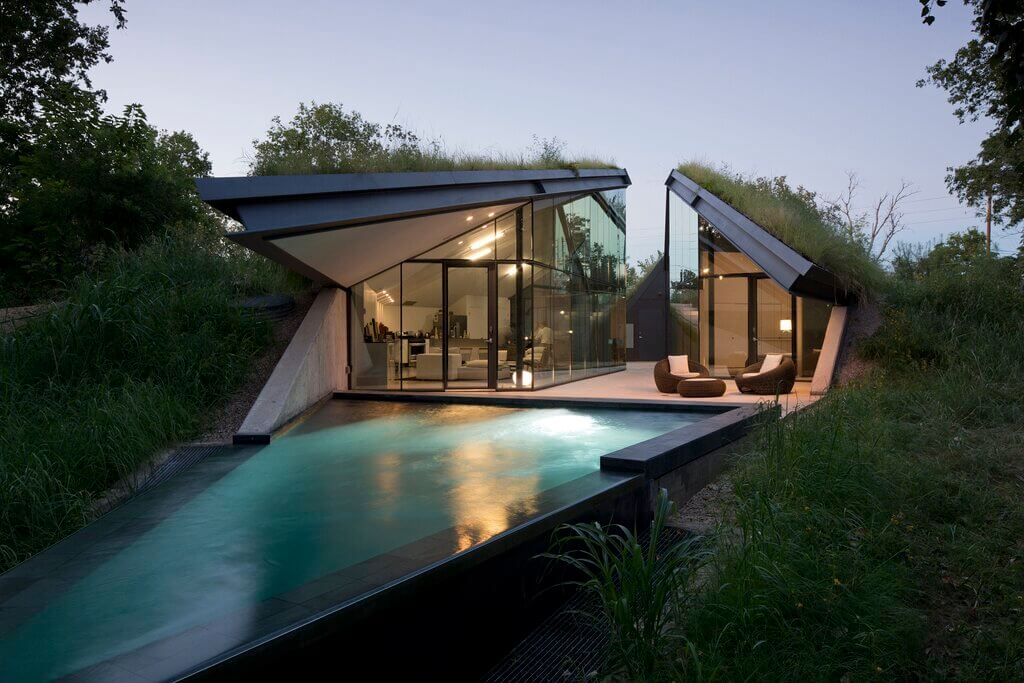
With our current bustling lifestyle, rewinding and staying rooted is all we desire. Catering to the denatured world are the concepts of sustainable houses letting you stay in sync with the natural atmosphere. Modern sustainable homes blend contemporary design sensibilities with a traditional construction approach. One such example is the Edgeland House by Bercy Chen Studio nestled on an area of one acre.
The house is a reinterpretation of the Native American Pit Homes. The conventional pit homes maintain a constant range of temperature inside as they are sunken into the ground. Edgeland House is shielded by a green roof serving as an insulator. The design has been planned and executed in a way that the natural settings aren’t tweaked or disturbed. Rather the adoption of various elements lets nature bloom to its maximum potential.
A few zones of the home go deep into the ground at a depth of seven feet. This design approach helps in regulating the temperatures in both summers and winters. The home blends with the landscape and acts as an extension of it by offering houses for 40 local wildflower species to grow.
7. Logie Point, Jersey, North Coast of France

Settled on a headland is Logie Point by Guz Architects. As sustainable houses seem to be a part of the natural settings, this house appears to be blooming from the sloping earth of the site. A blend with the natural surroundings lowers its impact on the environment.
One of the widely-adopted approaches in big or small sustainable homes is the roof garden. The concept of the same has been applied in this design for a seamless amalgamation of structure in the setting. The living areas are covered with curved roofs equipped with solar energy cells.
Both Logie Point houses are cladded with local materials and attain insulation and power with walls and roofs covered in photovoltaic cells. The home features a conserved courtyard in a part of the project that features a natural swimming pool being filtered with the conventional methods of reeds and plantations.
8. Haycroft Gardens, Northwest London
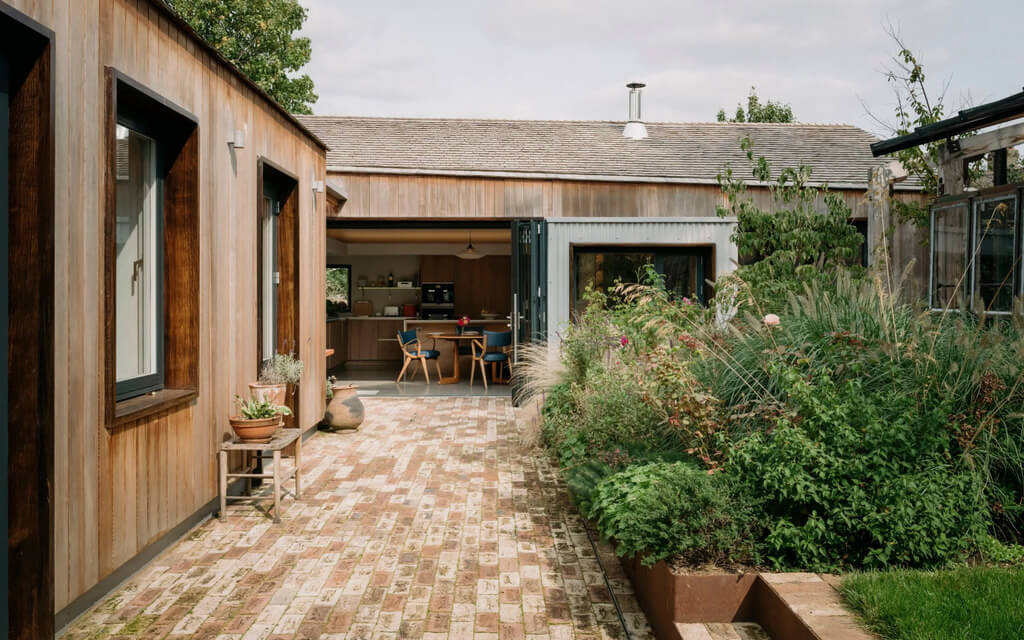
One of the most challenging parts of sustainable houses is the personal considerations. An example of one such project is the Haycroft Gardens by Sarah Wigglesworth Architects where apart from catering to the natural environment, designers also had to address the different set of requirements presented by the three generations living under one roof.
The project takes inspiration from the past, accommodates the present, and prepares for the future with energy efficiency, easy accessibility, and extra comfort in the house. The design has openly accepted Passivhaus principles to cut down the need for mechanical heating or cooling and maintain the temperature naturally.
The form of the structure in the L-shape aids in flooding the interiors with natural light and establishes a connection within each zone of the house. The central garden serves as a common relaxation spot for all the generations residing there.
9. W.I.N.D House, North of Netherlands

An example of the co-existence of modern lifestyle with natural settings can be seen in the W.I.N.D House by UNStudio. The property is located on the outskirts of a village at the peak of a hill. The wooded rear area and welcoming green fields in the front portion of the house make it extremely warm and inviting.
Smart planning of the house places the most private zones like bedrooms at the rear end and common areas like the living room and entertainment zone in the front. Social spaces are made more exhilarating as they open up to the panoramic natural landscape.
The entire design revolves around sustainability with solar panels, mood boards composed of natural materials, and a central feature with a waste heat recovery system. The smart home takes innovation to the next level with automation. A central screen can control all the spaces and even the solar panels. A device located in each room can help to regulate the ambiance based on personal needs and preferences.
10. Earth Sheltered Homes, Iceland
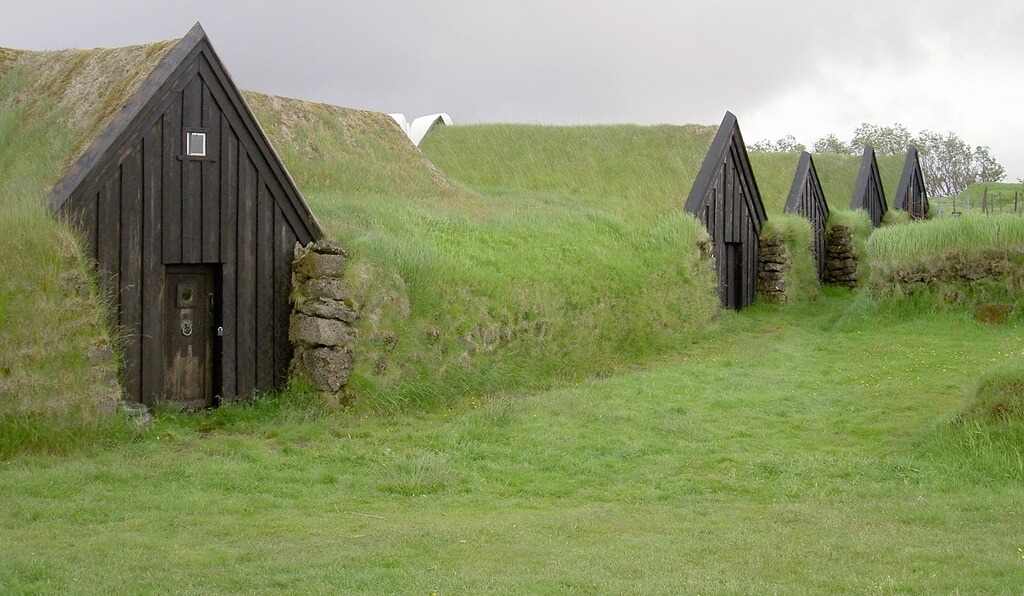
There’s no rule mandating the incorporation of modern technologies in order to attain sustainability. Sustainable houses can be derived from traditional practices of construction that had an environment-friendly approach deeply embedded within them.
These sustainable houses are great in energy efficiency and at the same time, serve as an affordable living solution. The sustainable tiny homes are constructed within hillsides with a seamless blending in the natural landscape. The turf homes dating back to the 900s are open for visitors. The residences of Southern Iceland are extremely sustainable with the most natural and rustic aesthetics. Being built inside the hills, these are weather-friendly solutions paving a path to better tomorrow.
11. The Brooks Avenue House, Venice, USA
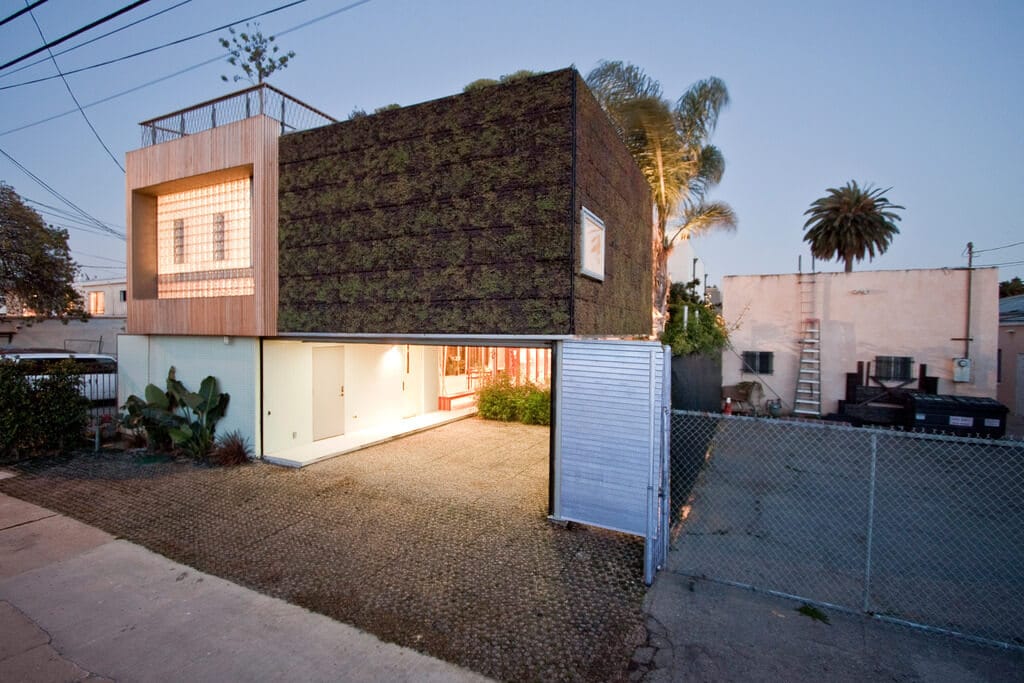
Known to build some of the most efficient eco-sustainable homes Bricault Design Vancouver-based architecture firm has designed this project. The architecture is not only captivating and beautiful but also gives an ode to nature. The modern home boasts a lush living wall on all facades of the house and a breezy roof garden. The Brooks Avenue house became an inspiration for sustainable homes.
Striking a mark on modern sustainable homes, this stunning structure is surrounded on three sides with the roof by a living system. The sustainable system includes an efficient vegetable garden and native low-maintenance grasses and shrubs. These vegetated facades are fed by a combination of captured rainwater and recycled domestic water generated by the residents. Furthermore, there’s also a cedar batten siding that helps shade the interior spaces keeping it at normal room temperature without the use of air conditioning.
The fundamental principle of sustainable homes is to ensure that it improves the quality of life for both humans and the wildlife in an urban setting, the Brooks Avenue house is one of the finest examples here. The concept is a simple and cost-effective way to beautify a home, make it more functional, and help clean up urban air pollution.
12. An Eco House in the Forest, Moscow, Russia
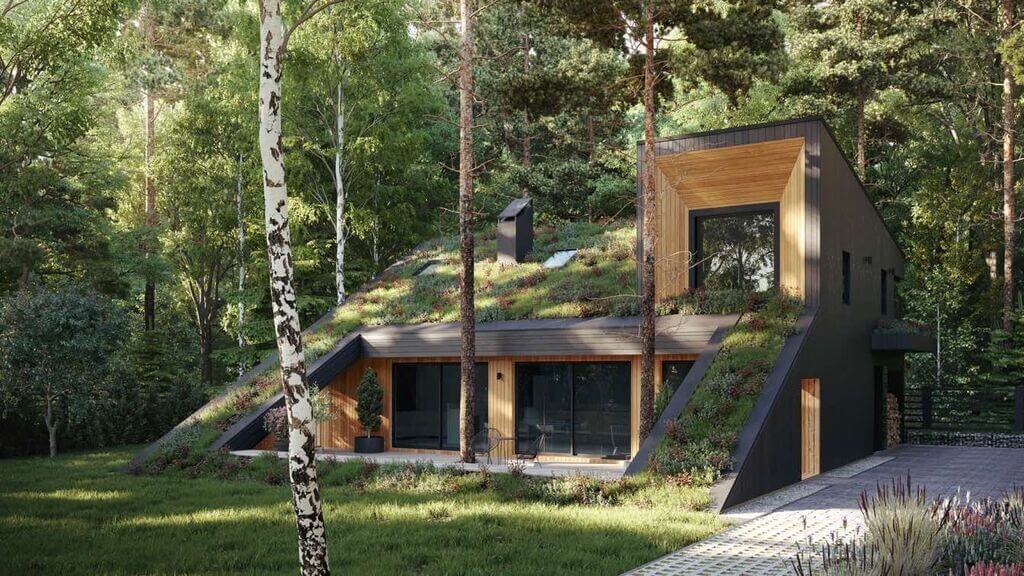
Sustainable houses are not only the nesting space for humans but also serve as a home to the existing natural features on the site. With such an approach fulfilling both demands, Snegiri Architects have derived this eco-house in the forest. This beautiful house nestling humans and nature helps in cutting down energy consumption by 90 percent of what’s normally utilized. All the design needed was passive techniques with a keen eye for technicalities.
The home seamlessly blends with the forest setting and preserves the natural habitat of all the existing trees. Composed of natural materials with a living roof, it’s a design that breathes. The energy-saver window feature faces the sun and serves as one of the vital elements to attaining energy efficiency. The design features Swedish cold-proof plate technology in which the blend of a foundation plate along with floor heating can be seen to keep the interiors at a comfortable temperature.
Though the structure looks modern and futuristic, the interiors reveal a different story. Interior spaces are ornamented with historic furniture and vintage items retaining an artistic and classic charm.
13. Superadobes in the Desert
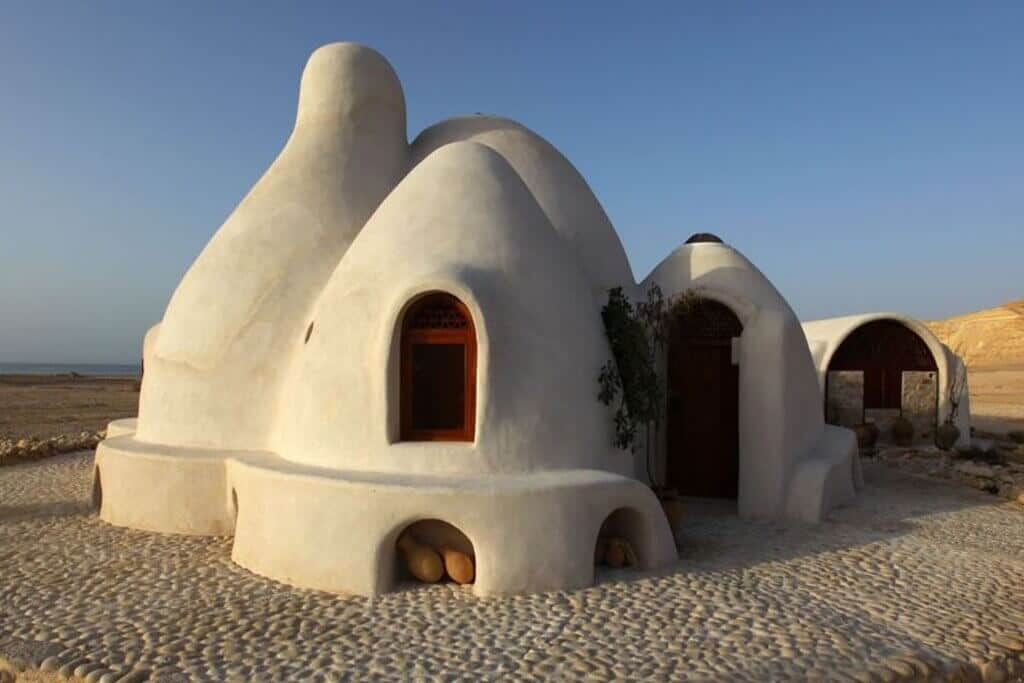
Sustainable houses are not only the nesting space for humans but also serve as a home to the existing natural features on the site. With such an approach fulfilling both demands, Snegiri Architects have derived this eco-house in the forest.
The home seamlessly blends with the forest setting and preserves the natural habitat of all the existing trees. Composed of natural materials with a living roof, it’s a design that breathes. The energy-saver window feature faces the sun and serves as one of the vital elements to attaining energy efficiency.
14. A Long Island Eco House in the Reach of New York, Peconic Bay
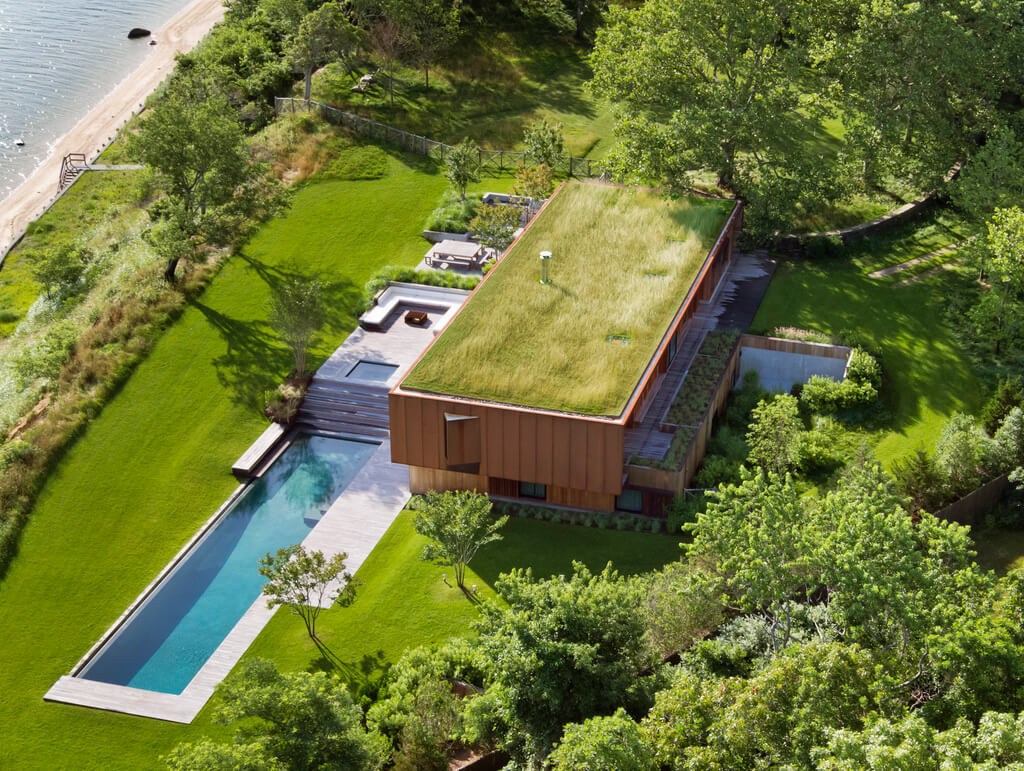
Amidst the perfect location is a proposal of one of the most beautiful eco-sustainable homes– Long Island Eco House by Studio Mapos. Isolated yet connected, modern yet rooted in the definition of the design of this sustainable house. The rawness of the untreated woods along with concrete and steel lets the perfect fit well in the lush green surroundings and enjoy the live painting of Long Island bay.
The naturally existing fauna is what has guided the entire design and concept of the house. With minimal alterations in the natural conditions, the home pays respect to the existence of nature and takes it as one of the most beautifying elements of the sustainable architecture of the home. The home is planned along the East-West horizon keeping into consideration the naturally existing slope that makes the house look like it is growing from the plot.
As one recedes the stepped terrace, you land in an infinity pool that further lets you dive into another natural element while enjoying the scenic views. A splash of white with wood composes the home interiors and makes it feel welcoming.
15. An Eco House Hidden in Dunes, Nijmegen, Netherlands

There’s nothing as inspiring as the natural patterns. One such inspiration for recreating the essence of walking through the dunes was adopted in the eco-sustainable homes amongst dunes. This holiday home running on the concepts of sustainability is muted yet extremely expressive with its asymmetrical roof amidst the surrounding.
Every window and door opening of the home follows a strategic positioning as it opens up to the magnificent natural views. The form, accents, textures, and material palette of these sustainable homes facilitate a seamless amalgamation of the design in a naturally painted scenery.
The house pays homage to the environment with prefab components and the installation of energy-saving solutions like solar panels, biomass fireplace, and other passive heating options cutting down the consumption of artificial energy.
16. An Eco Home Deep in Tropical Forest, Valle de Bravo, Mexico
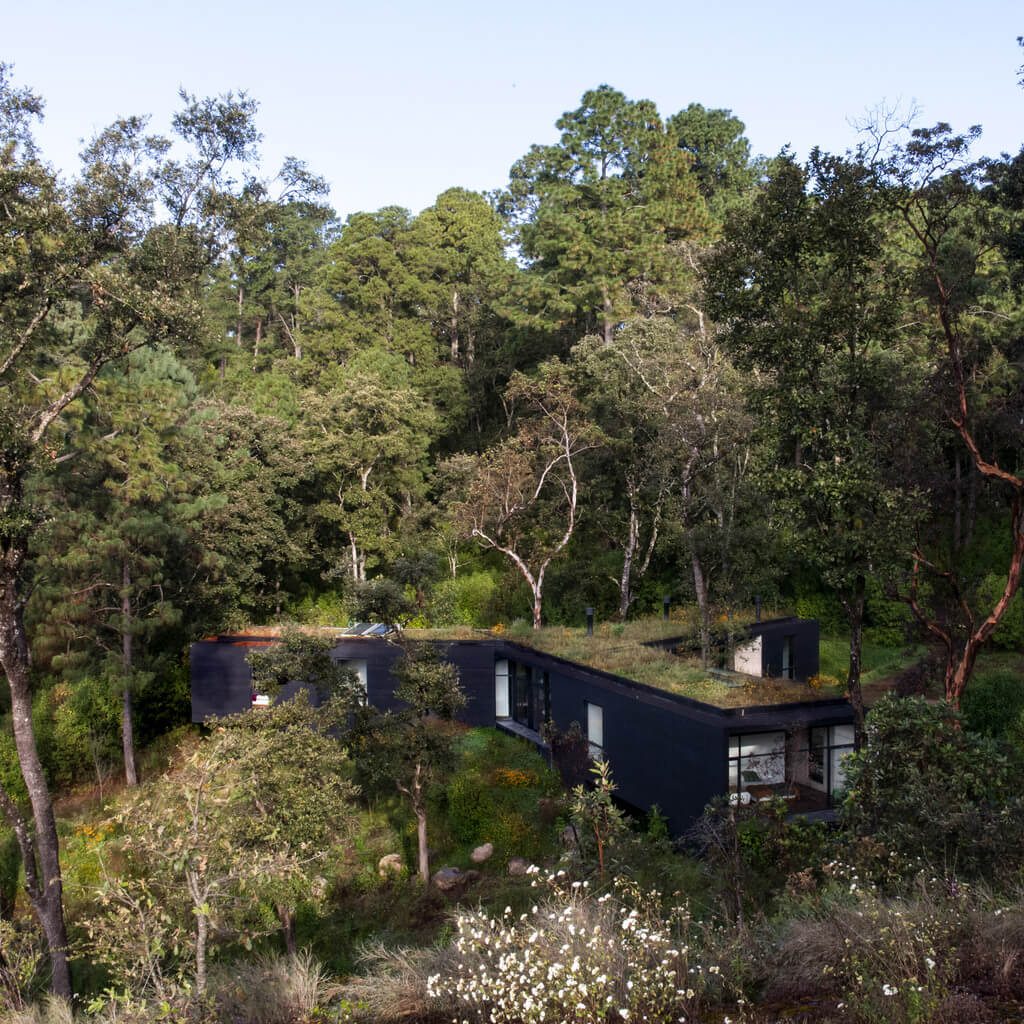
Celebrating nature and its rich setting is the Casa de la Roca Home– an eco-home nestled within a dense tropical forest. The house camouflages within the hill and the rustic appeal syncs well with the natural picture.
Modern sustainable homes draw inspiration from natural materials and the same route has been taken in this design project. The forestry elements are what compose the entire design of the residence with a careful selection of fallen trees. A few hand-picked trees were taken and used to compose the beam layout of the house for a structurally sound design.
With lookouts directed in three different directions, each one offers a unique view rich in landscaping. The green living roof of the house offers desired insulation levels and serves as a basin to catch rainwater. Apart from these sustainable features, nestling on the green roof is a range of wildlife. Catering to the definition of eco-sustainable homes, this structure is a house for the coexistence of humans and nature.
17. A Garden Oasis in Bustling Buenos Aires

Everyone seeks a retreat from the daily hustle to revitalize and connect with nature. Addressing this common demand in residential designs is the MeMo House by BAM! Arquitectura. A sustainable approach to the design resulted in minimal impact on nature and maximized comfort within the house.
A 3D garden begins at one point and flows through every floor of the house, thus, serving as a garden oasis in the bustling city life. The core principle of design revolved around health. This led to the optimization of natural light and magnificent views through large picturesque windows.
The house has been identified as one of the LEED-certified sustainable houses of Argentina with advanced technologies like wastewater, solar panels, etc., catering to the energy demands of the structure.
Towards a Greener Future with Sustainable Houses…
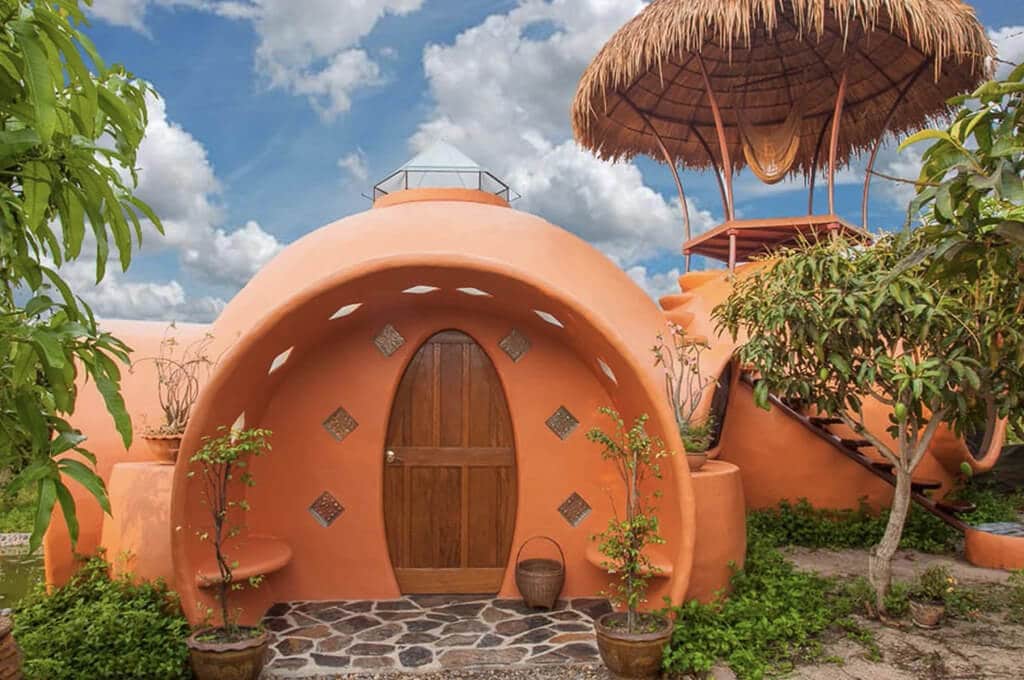

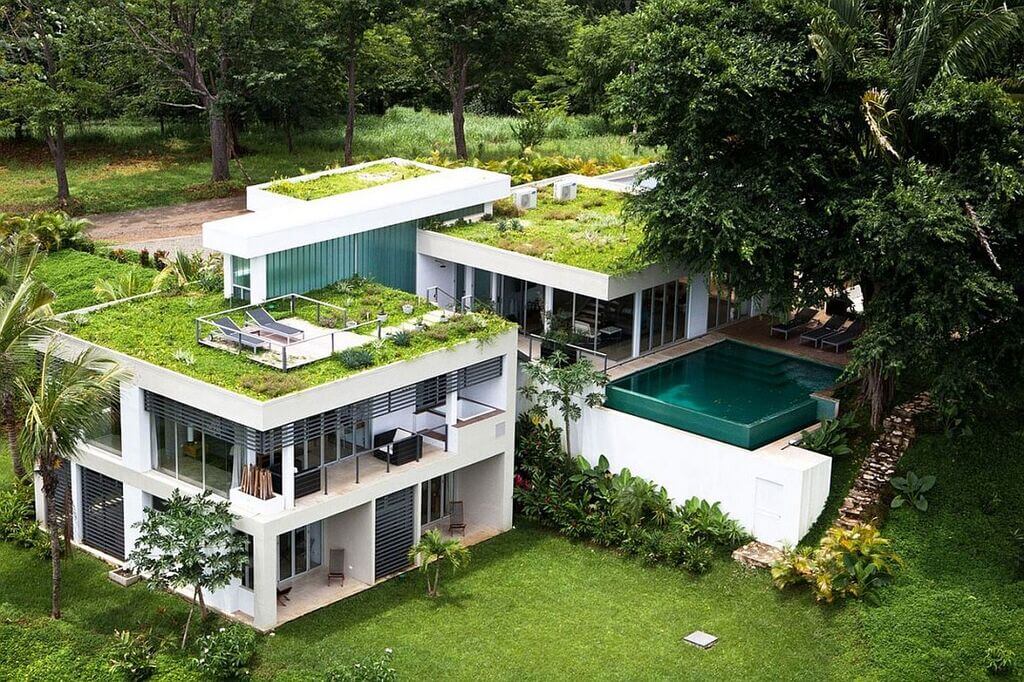
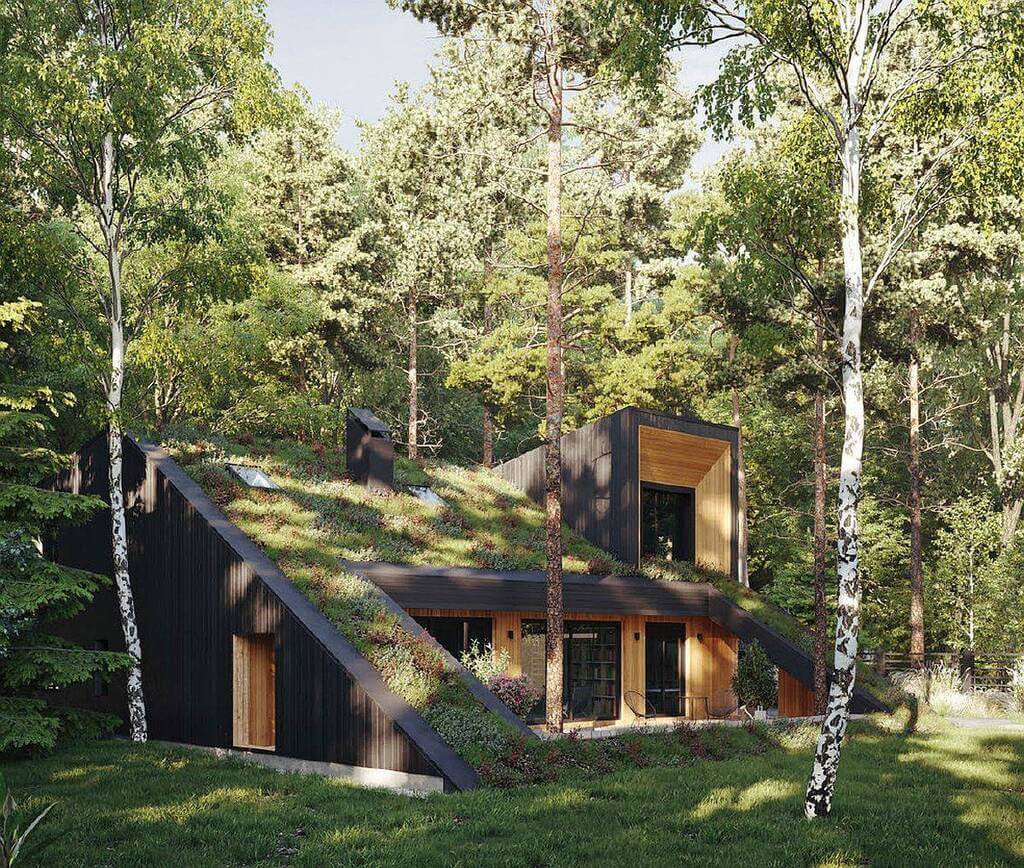
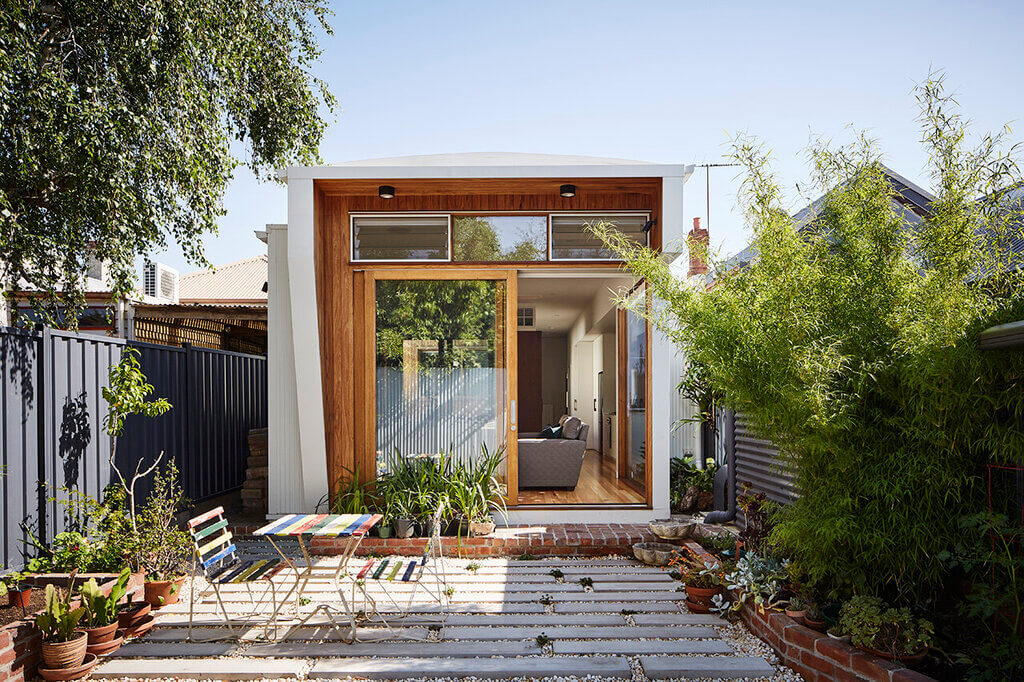

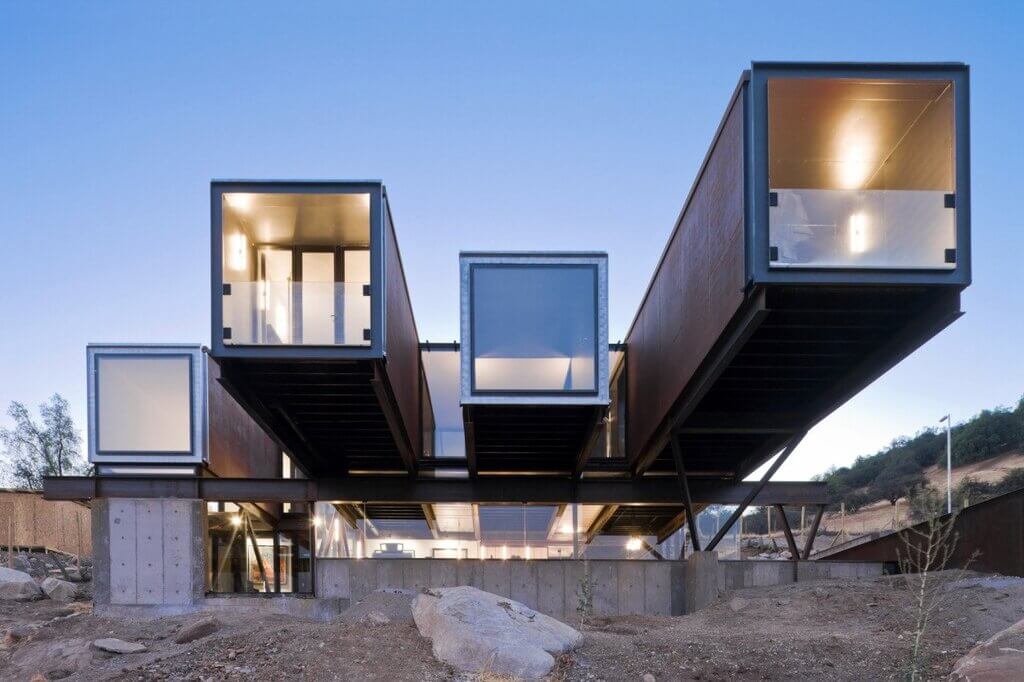
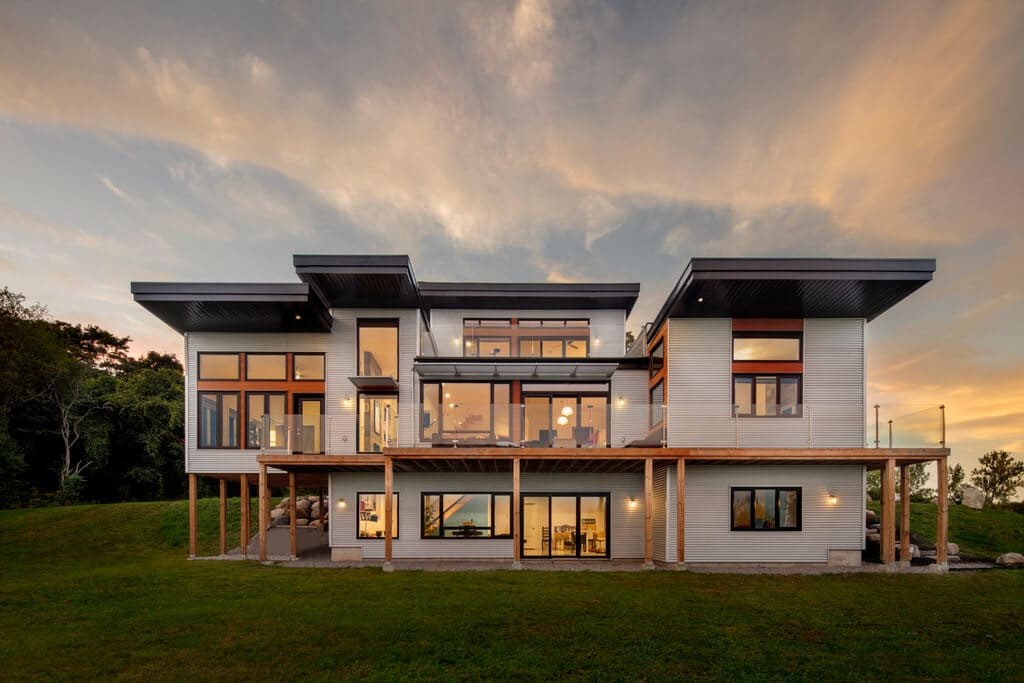

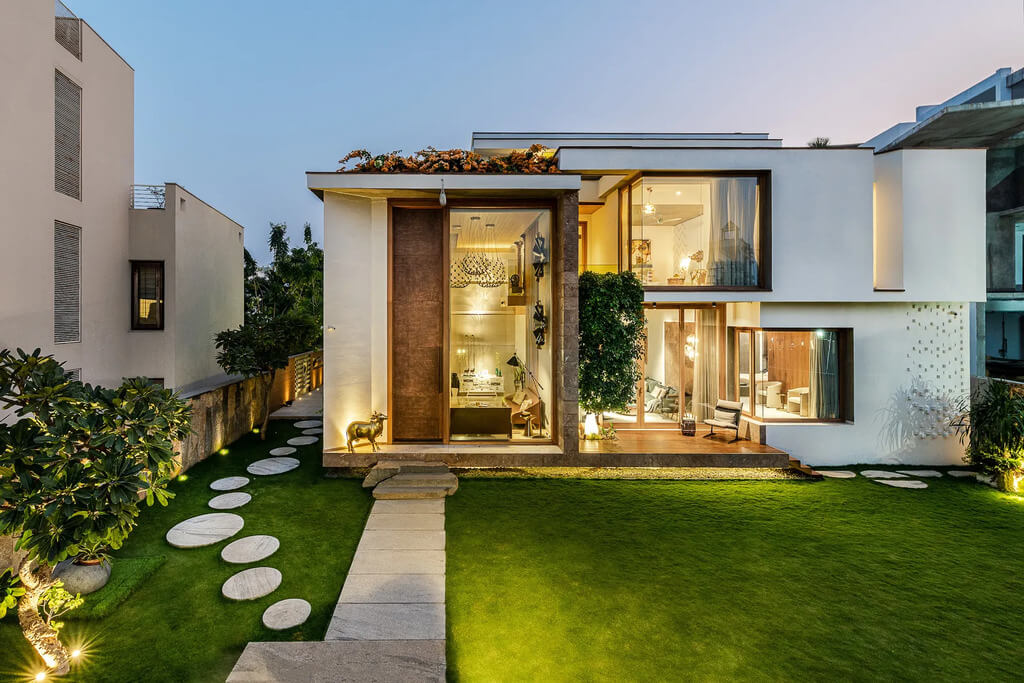

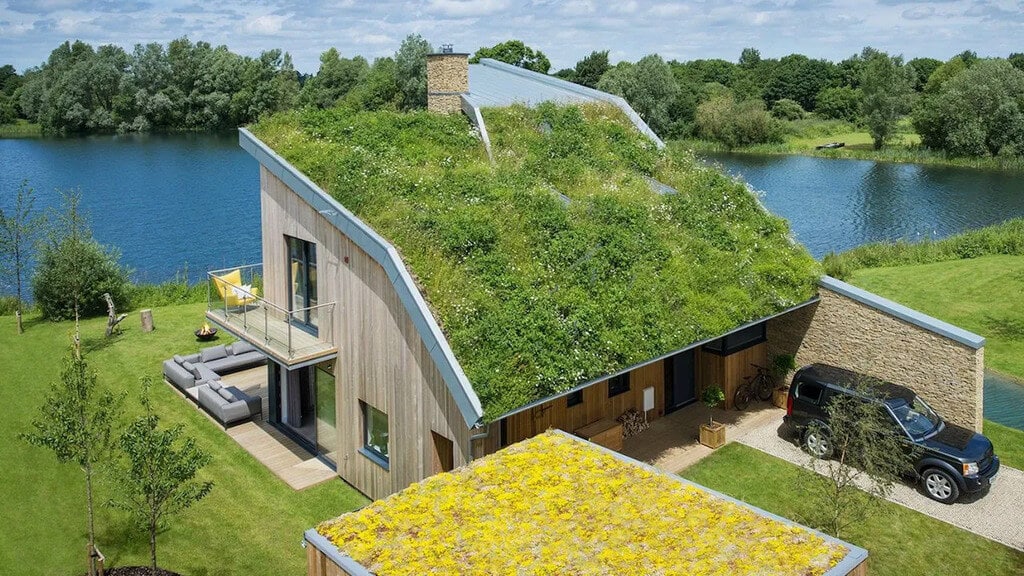
Sustainability or sustainable homes is no longer going to remain a design concept. Rather, it’s a lifestyle that needs to be adopted. A mix of modern and traditional can lead to a highly-efficient building design that borrows sleek and sublime aesthetics from the modern design language and eco-friendliness from the conventional construction practices.
Eco-sustainable homes can prove to be one of the co settle in owing to the natural essence and aura they impart. As we’re headed towards greener days, let’s reestablish our connection with nature by building sustainable homes.
FAQs
Sustainable houses are the ones that minimize the consumption of energy and take a local route in terms of materials or construction techniques. These homes take into consideration the local climatic conditions, vernacular materials, and practices. These can either be blended with modern technology or executed as it has been done since the old times. The main goal of sustainable homes is to maximize users’ comfort and reduce the environmental impact of the structure.
Construction of a sustainable home needs you to look into the climatic factors, research conventional materials and practices, and plan the design as per. You need to assess how the usage of natural resources can be maximized in your design to cut down the need for mechanical services.
Whether it’s a large-scale project or small sustainable homes we’re talking about, eco-friendliness can only be derived from the use of natural materials. A modern approach takes advantage of recyclable materials like glass bottles, tires, etc., for energy efficiency.
With the extreme exploitation of resources and damage already done to the environment, there needs to be an awakening call to drift towards sustainability in each sector. Sustainability in construction results in comfortable homes minimizing mechanical energy and maximizing the use of natural resources.
The tall tree-like grass, i.e Bamboo is a fast-paced material that is widely adopted in various sustainable home designs, daily household essentials, and even as raw material in the fashion industry. It is an extremely eco-friendly material in the construction industry offering advantages like durability in structure and unmatched aesthetics. The versatility of the material can be taken advantage of to use in structures, floors, or even as wall panels.
Read More:-

